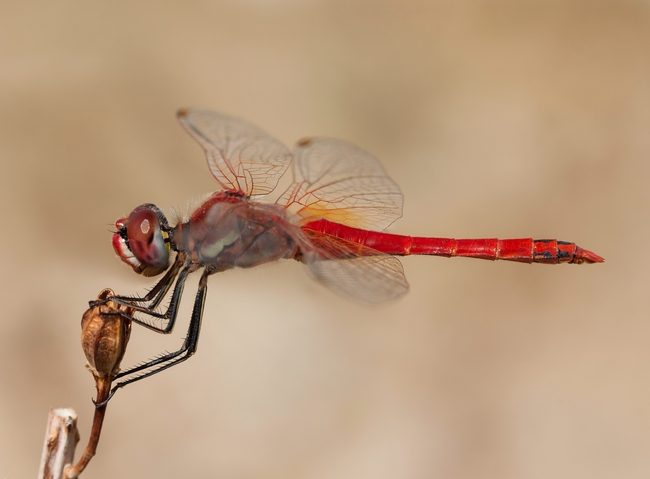In this blog series, Dr. Annemiek Schilder, Director, UCCE Ventura County and Hansen Agricultural Research and Extension Center, shares her observations about the natural world across the seasons. As she says:
"Gently observing your surroundings with curiosity will teach you some amazing things. There are so many fascinating things happening under our noses, only wanting for an observant eye."
The other day I spotted a gorgeous red dragonfly in my garden. He – yes, it was a male - cocked his head towards me several times and studied me with his big compound eyes as I inched closer to take a picture. He waited patiently while I tried to get him into focus, then eventually flew off. The flame skimmer dragonfly (Libellula saturata) is common in California and the Western US. Males have an orange-red body with orange sections on the wings, whereas the female is paler with an amber tinge along the upper edge of the wings.
Dragonflies speak to the imagination with their bright colors, transparent lacy wings and aerial acrobatics, inspiring poets and artists through the ages. They are often seen as a good omen and a source of comfort during times of loss. In Japan, the dragonfly is a symbol of strength, courage, and happiness whereas to Native Americans, dragonflies signify change, transformation and healing.
Dragonflies belong to the insect order Odonata, which means “toothed”, for their serrated mandibles − entomology-speak for jaws with teeth-like projections. Adult dragonflies feed on soft-bodied insects such as mosquitoes, flies, moths, butterflies, and flying ants, ambushing them in mid-flight. They have almost 360-degree vision due to their huge compound eyes and can see many more colors than humans can. Dragonflies are amazing flyers, achieving speeds over 30 miles per hour, and are able to fly forwards, backwards and remain stationary with the help of flight muscles that control each of the four wings separately.
The flame skimmer dragonfly is mostly found near warm ponds or slow-flowing streams. In colder regions they are a common sight around hot springs. The larvae, also called nymphs or naiads, spend 2 or more years living in shallow water where they feed on mosquito larvae and other aquatic insects, small fish and tadpoles. In order to grow, they have to molt (shed their skin) multiple times. Adult dragonflies emerge in the spring and live for about 6 months during which time they have to find a mate. As I was observing two flame skimmers chasing each other, I was reminded that dragonflies can be fiercely territorial. After mating, the female lays her eggs by dipping her abdomen repeatedly in the water while hovering above the surface.
Watch the life cycle of dragonflies in this National Geographic video.
Related Reading:
Fireworks in the Garden: Octopus Agave
Photo by Sensei Minimal on Unsplash
Attached Images:
